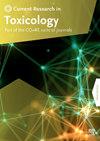Profiling assay performance in the DevTox germ layer reporter platform
IF 2.9
Q2 TOXICOLOGY
引用次数: 0
Abstract
The U.S. Environmental Protection Agency (U.S. EPA) is mandated to develop new approach methods (NAMs) to detect chemicals risks to susceptible populations, including effects on pregnant women and their offspring. With limited hazard information available for current and new chemicals, NAMs can provide greater relevance to human biology, mechanistic insight, and higher testing capacity than traditional animal models. The DevTox Germ Layer Reporter (GLR) model platform was recently established for high-throughput screening and prioritization of potential developmental hazards. The model platform utilizes the RUES2-GLR pluripotent stem cell reporter line that expresses fluorescent fusion protein biomarkers SOX17 (endoderm), Brachyury (mesoderm), and SOX2 (ectoderm and pluripotency); enabling a multi-lineage readout of gastrulation lineages. The DevTox GLR-Endo assay used the model platform to evaluate chemical effects on differentiating endoderm, yielding a balanced accuracy (BA) of 72% against a training set of 43 developmental toxicants and 23 non-developmental toxicants. To assess the predictivity of additional early embryonic lineages, assays for pluripotency (DevTox GLR-Pluri), ectoderm (DevTox GLR-Ecto), and mesoderm (DevTox GLR-Meso) were developed. Chemical reference set (12 developmental toxicants and 4 non-developmental toxicants) activity for each assay revealed BAs of 92% for DevTox GLR-Endo and DevTox GLR-Pluri, 71% for DevTox GLR-Ecto, and 58% for DevTox GLR-Meso. Expanded testing of the DevTox GLR-Endo and DevTox GLR-Pluri with 63 developmental and non-developmental toxicants yielded BAs of 75% and 68%, respectively. Amongst the four DevTox GLR platform assays, the DevTox GLR-Endo assay maintained the highest degree of efficacy and overall predictive accuracy for the compound set evaluated in this study.

在DevTox细菌层报告平台上分析分析性能
美国环境保护署(U.S. EPA)被授权开发新的方法(NAMs)来检测化学品对易感人群的风险,包括对孕妇及其后代的影响。由于现有和新化学品的危害信息有限,NAMs可以提供与人类生物学更大的相关性,机制洞察力和比传统动物模型更高的测试能力。DevTox胚层报告(GLR)模型平台最近建立,用于高通量筛选和优先考虑潜在的发育危害。该模型平台利用RUES2-GLR多能干细胞报告系,表达荧光融合蛋白生物标志物SOX17(内胚层)、Brachyury(中胚层)和SOX2(外胚层和多能层);实现原肠胚谱系的多谱系读出。DevTox GLR-Endo试验使用模型平台评估化学物质对分化内胚层的影响,在43种发育毒性物质和23种非发育毒性物质的训练集上获得了72%的平衡准确度(BA)。为了评估其他早期胚胎谱系的预测性,我们开发了多能性(DevTox GLR-Pluri)、外胚层(DevTox GLR-Ecto)和中胚层(DevTox GLR-Meso)的检测方法。每种测定的化学参考集(12种发育毒性物质和4种非发育毒性物质)活性显示,DevTox GLR-Endo和DevTox GLR-Pluri的BAs为92%,DevTox GLR-Ecto为71%,DevTox GLR-Meso为58%。对DevTox GLR-Endo和DevTox GLR-Pluri进行了扩展测试,其中含有63种发育和非发育毒性物质,ba分别为75%和68%。在四种DevTox GLR平台检测中,DevTox GLR- endo检测对本研究中评估的化合物集保持了最高的有效性和总体预测准确性。
本文章由计算机程序翻译,如有差异,请以英文原文为准。
求助全文
约1分钟内获得全文
求助全文
来源期刊

Current Research in Toxicology
Environmental Science-Health, Toxicology and Mutagenesis
CiteScore
4.70
自引率
3.00%
发文量
33
审稿时长
82 days
 求助内容:
求助内容: 应助结果提醒方式:
应助结果提醒方式:


